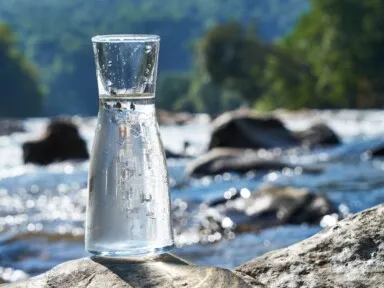While you may recognize spring, distilled, and purified water, you may not have encountered artesian water before. Of the many types of water, artesian water is produced via a unique natural phenomenon, which has spurred some common misconceptions about its purity.
Whether your drinking water is sourced from an artesian well or you’re interested in water sustainability, let’s explore what you need to know and answer the question: What is artesian water?
In this article:
Geological Formation of Artesian Water
Artesian water comes from a deep underground water source. Let’s break down the process of artesian water, going from aquifer to well.
Understanding Aquifers
Aquifers are a layer of permeable rock where water is stored and can be a water source for wells and springs. There are three types of underground aquifers: unconfined, confined, and perched.
An unconfined aquifer sits beneath the soil of the Earth’s surface, and a perched aquifer is a small pocket of water that sits above the water table. Artesian water comes from confined aquifers, which are located deeper in the Earth beneath confining layers of impermeable rock.
The Artesian Aquifer System
Confined aquifers are created through precipitation and are under considerable natural pressure, pushing the water to the Earth’s surface and filtering it through layers of rock and sediment.
Artesian Wells: Accessing Artesian Water
Artesian wells differ from typical groundwater or spring wells in several ways.
What is an Artesian Well?
Wells that gather water from confined aquifers are called artesian wells. The main distinguishing characteristic of these wells is that they often don’t require a pump, as the water naturally fills the well due to the underground pressure. The word “artesian” can be traced back to the French town of Artois, where the first artesian wells were drilled in the Middle Ages.
How Artesian Wells Work
Because of the pressure that pushes the water upwards through confining layers, artesian water goes through a natural filtration system. Artesian water is extracted from the ground by drilling a well into a confined aquifer.
Flowing vs. Non-Flowing Artesian Wells
Some artesian water systems have enough pressure to push the water above the ground surface and fill a well — these are called flowing artesian wells. Non-flowing artesian wells require a pump to extract the water from beneath the surface of the Earth.
Characteristics and Quality of Artesian Water
Artesian water is lauded for its natural filtration and unique mineral content, but that doesn’t mean it’s safer than other water.
Natural Filtration Process
By passing through layers of rock and sediment on its way to the Earth’s surface, artesian water goes through a natural filtration, reducing most impurities and particles from the water. However, just like any type of well water, it must be tested before consumption as it could still contain bacteria, viruses, and other potentially harmful contaminants.
Mineral Content and Composition
As it passes through different ecological layers, artesian water may accumulate minerals along the way. Here are some common beneficial minerals in artesian water:
-
- Calcium
-
- Magnesium
-
- Potassium
-
- Fluoride
Purity and Safety Considerations
Although artesian water goes through a natural filtration process and is mineral-rich, it’s not necessarily safe to drink straight from the well. This water must be tested and purified before consumption, whether to remove potentially harmful microorganisms or contaminants, such as pesticides, arsenic, or lead. Consuming unsafe artesian water can lead to minor or major health issues, such as kidney damage.
Artesian Water vs. Other Types
Here’s how artesian water differs from groundwater or spring water.
| Type of Water | Formation | Extraction Method | Water Quality |
| Artesian Water | Precipitation gathers in a confined aquifer | Artesian well | Filtered and mineral-rich but not necessarily safe |
| Groundwater | Precipitation gathers in unconfined aquifers | Well | Less susceptible to bacteria and mineral-rich but not necessarily safe |
| Spring Water | Precipitation overflows an aquifer, pushing the water to the Earth’s surface | No well needed | Filtered and mineral-rich but not necessarily safe |
Filtered But Not Clean Water
Artesian water is gathered in confined aquifers, powered by pressure, and pushed through layers of rock to flow to the land’s surface. While artesian water goes through a unique natural phenomenon compared to groundwater or spring water, not all artesian well water is safe to drink, so it is extremely important to have the water tested before drinking.
FAQs
Artesian water naturally rises to the surface of the Earth from underground wells. Artesian wells don’t require a pump because of the pressure underground, but the water itself doesn’t have any unique properties as some people believe.
Artesian water doesn’t require a well pump and goes through a sort of natural filter when pushed to the surface. Unfortunately, that doesn’t mean the water is clean enough to drink in its natural state. Another disadvantage is that artesian wells can eventually run dry because of environmental changes.
Artesian water is just as susceptible to contaminants as other types of groundwater, so it’s not necessarily safe. Bottled water from an artesian well, however, is safe.
While the aquifers that feed artesian wells can be thousands of feet deep, the wells themselves are not necessarily deeper than a regular groundwater well.




